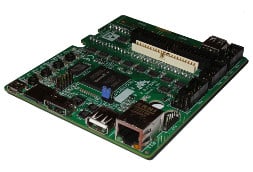Introduction
A field-programmable gate array (FPGA) is an integrated circuit designed to be configured by a customer or a designer after manufacturing – hence the term "field-programmable" (from Wiki). In the Amiga world, FPGA have been used to make new accelerator cards to complete replication of the original Amiga chipsets. This page will only focus on the complete replication system that have been made in the Amiga world.
Vampire V4 / UnAmiga / Mist / Mini Mig
Apollo V4 (Vampire)

There has been a real buzz in the Amiga community over the latest FPGA Amiga, Vampire V4, now renamed Apollo v4 is not just another reinterpretation of Amiga hardware but more like what the next classic Amiga might have been had it continued to be developed. Designed to be both an accelerator for the A1200 or an independent device. The unit features a 68080 CPU that can power the classic Amiga much faster than any old accelerator could. The graphics have also been improved with what's been called Super-AGA, this allows the system to display full AGA graphics support but also adds extra features like up to 12mb of Chip Ram, faster Blitter and Copper support, faster ram access, video accelerated hardware and HDMI support, full specs below.

- Apollo 68080 CPU
- Performance is application dependent: up to ~ 1000 MHz 68030 / 500 MHz 68040 / 250 MHz 68060 speed
- 512 MB DDR3 memory
- Dual Flash chips
- FastKick
- Super-AGA GFX Core: Truecolor DIGITAL VIDEO OUT
- FastIDE/CompactFlash controller 13 MB/s
- SDcard for data exchange
- USB
- RJ45 100BaseTX Ethernet
- Expansion ports (e.g. Wifi Module)
- £549.99
The system can run AmigaOs 3.1/3.1.6 and 3.2. But due to legal issues of supplying the system with the Roms, the Apollo team decided to support and develop there own fork of Aros 68k with there own OS named ApolloOS. Find out more about the OS here.
http://www.apollo-computer.com/ - Official site
http://www.apollo-core.com/knowledge.php - Forum
https://www.facebook.com/groups/1426384837419519 - Facebook Page
https://www.apollo-accelerators.com/ - old Official site
http://wiki.apollo-accelerators.com/doku.php/start - Wiki
https://amigacoffin.com/ - Apollo OS / Coffin OS designed for Vampire boards
https://www.youtube.com/watch?v=YRr74v2tPzM - Video about the history of Vampire v4
https://www.youtube.com/watch?v=Ml6VyEMoAaY - Video about Apollo Accelerators
UnAmiga
The UnAmiga A500 header was designed to fit inside a real A500 or a Checkmate 1500 case. The header outputs all the required signals from the FPGA to convert your empty case into a fully working A500 020 with AGA. This new version has been completely redesigned from the ground up. Now includes a 24 bit video DAC and a 10 bit i2s audio DAC. The sound quality is beyond the original Amiga. FPGA board, SD card and power supply included with the header. A new UnAmiga ITX version came out to support the ITX Checkmate mini case.
Specifications:
- FPGA Board Included.
- 24bit videodac to output VGA 15khz/31khz output (depends on the core).
- Power plug vía JACK or via MICROUSB B.
- Power switch.
- MicroSD reader.
- 14bit I2S audiodac to output 3.5mm audio jack and Dual stereo RCA jacks.
- One amiga Joystick port and one Amiga Mouse port (DB9).
- External PS2 Keyboard and Mouse available.
- ESP8266 port for serial connection header (esp8266 not included).
- Floppy buzzer.
- HDD, FDD and POWERLED output.
- A500 keyboard connector (you can use your original A500 keyboard with this board).
- SoftLatch circuit for the CheckMate 1500 case.
- SD card with software included for free.
- From £165 to £280 (Depends on the version ITX/A500)
Amiga Core Specs:
- 68020 AGA Core
- 2MB of chip ram.
- 20 MB of fast ram.
- Floppy emulation via ADF’s (two floppies available)
- HardDrive Emulation via HDF’s (two files can be set up to two drives).
https://github.com/benitoss/UnAmiga - Github home page
http://www.forofpga.es/ - Spanish FPGA Forum
https://www.checkmate1500plus.com/Products.aspx?id=364 - UnAmiga ITX details and videos
Mist / Mister
The MIST board was designed to implement classic 16 bit computers like the Amiga, Atari ST(E) or the Apple Macintosh (and even early 32 bit computers like the Acorn Archimedes) as a System-on-a-Chip using modern hardware. But it equally will support 8 bit systems like the Atari 800/XL, ZX81, ZX Spectrum, C64, Atari VCS, Atari 5200, Colecovision, Apple II, Sega Master System, Nintendo Gameboy, Nintendo NES, Odyssey2 plus others. Of course 16 bit console systems such as SNES, Genesis/Megadrive, PC Engine are also supported. The system also supports over 100 Arcade games! The project expanded way beyond its original goal and so a more expandable and much more powerful version came along, MISTer, this allowed much more powerful and high spec systems to be run on the FPGA.
Orginal Mist
- Altera Cyclone EP3C25 FPGA
- 32 Megabytes 16 bit wide SDR SDRAM
- AT91SAM7S56 ARM IO controller
- MAX3421E USB host controller
- TUSB2046 USB HUB
- 1 x Analog VGA output with 3*6 bits colour depth
- 1 x Stereo analog audio jack 3,5mm
- 1 x SD Card Slot
- 4 x USB (for keyboards, mouses, joysticks...)
- 2 x Classic joystick connectors (Atari\'s specification DB9: Amiga, Atari, Amstrad, C64, etc)
- 3 x LEDs (Power, FPGA and IO Controller)
- 3 x Pushbuttons (Board Reset, Menu, Core defined)
- 1 x Micro USB connector for power supply and IO Controller flash update
- 1 x Power Switch
MISTer
- Altera Cyclone V with two ARM Cortex-A9 CPU cores,
- 1GB of DDR3 SDRAM,
- HDMI out
- a microSD card slot
- a USB-A port,
- Ethernet connectivity
- GIO pins
- £150 to £500 for complete set up kits
The best thing about MISTer is it expandability thanks to the GIO Pins you can add different kind of boards for different project, like adding WiFi, Bluetooth support, Original 9 Pin Joypad port, VGA out, more USB port etc. Find out more on the below links
https://github.com/mist-devel/mist-board/wiki - Git Hub Home page
https://misterfpga.org/ - MiSTer FPGA Forum
https://misterfpga.co.uk/ - MiSTer Shop (uk)
https://www.reddit.com/r/MiSTerFPGA/ - Reddit Discussion group for project and info.
https://www.youtube.com/watch?v=lVPa5EW5mp8 - General Use Video
https://www.youtube.com/watch?v=rhT6YYRH1EI - Good Break down / Comparison Video
https://www.youtube.com/watch?v=F5__shDTYMQ - Getting Started Video
Mini Mig
Minimig started around January 2005 as a proof of concept by Dutch electrical engineer Dennis van Weeren. He intended Minimig as the answer to the ongoing discussions within the Amiga community on implementing the Amiga custom chipset using an FPGA. The project's source code and schematics were released under version 3 of the GNU General Public Licence on 25 July 2007.
- Xilinx Spartan-3 400k gate (XC3S400-4PQ208C) FPGA using 82% capacity.
- Freescale MC68SEC000, 3.3V, at 7.09379 MHz. However, there's no 'E' clock, MOVE sr,<EA> is privileged and there is no real replacement instruction. This does not seem to affect any programs yet.
- Amiga Chip RAM bus and Slow RAM merged into a single synchronous bus running at 7.09379 MHz.
- 2 MB 70 ns asynchronous SRAM organised as 2x 524 288 x 16-bit banks.
- MCU PIC 18LF252-I/SP[3] (An alternative is Atmel AVR) implements a FAT16 disk layout and handles loading of FPGA configuration and Kickstart. Simulates a floppy to the Amiga by encoding on the fly from ADF files.
- MMC Flash memory card to load FPGA configuration, kickstart and software for the implemented computer.
- 3× LEDs to display the disk activity, main power and Amiga power up status (no existing audio filter!) Amiga power up status led will change intensity to show audio filter status.
- Video D/A consists of 4 resistors for each color red, green, blue (4 bits/color) and output via VGA connector.[4]
- Audio from an 8 bit dithering sigma-delta converter with 2nd order analogue filter.
- +5V DC main power (~200 mA).
- Spare 3x generic I/O from the FPGA (GPIO)
- JTAG for programming chips (TMS, TDI, TDO, TCK)
- RS232 serial port
- 2x Joystick of Atari 2600 DE9M type.
- DE15F VGA video (which can output PAL compatible signals to connect to SCART).
- MMC Flash memory card slot.
- PS/2 connector Keyboard + Mouse
- 3.5 mm audio jack
- +5V DC 2.1 mm cylindrical DC plug power supply inlet.
- £350
https://en.wikipedia.org/wiki/Minimig - wiki
https://www.minimig.ca/ - Web store / info on Minimig
https://retrogamecoders.com/mister-fpga-amiga/ - How to setup Mini Mig
https://www.acube-systems.biz/index.php?page=hardware&pid=3 - A-Cube old support / product page
https://www.youtube.com/watch?v=686rwv2R5pQ - Developer
Media
https://www.youtube.com/watch?v=LxMaXQJiUkk - Ravi Abbot Great run down of Amiga you can buy, including FPGA Amiga
https://www.youtube.com/watch?v=bigaln3swU8 - Smoke Monster looks at MiSTer FPGA
https://www.youtube.com/watch?v=YRr74v2tPzM - Retrobyte look at Vampire V4
https://www.youtube.com/watch?v=9zaDLI19RTU - Guru Mediation first look at Vampire V4
https://www.youtube.com/watch?v=BKXhKhc9W7k - UnAmiga, video by Checkmate cases
https://www.youtube.com/watch?v=VjpUWwEGoUw - A look at Minimig 1.8, by Chris Edwards
Further Reading
Minimig - https://www.minimig.ca/
UnAmiga Reloaded - https://www.arananet.net/pedidos/prod...
FPGA Mister - https://misteraddons.com/
Mister Multisytem - https://rmcretro.store/multisystem-bo...
Mist 1.4 - https://lotharek.pl/productdetail.php...
Neptuno - https://www.antoniovillena.es/store/p...
MultiCore 2+ - https://loja.victortrucco.com/multico...
SiDi Fpga - https://manuferhi.com/p/sidi
https://retromodsblog.wordpress.com/2020/01/28/which-fpga-is-the-best-for-amiga/ - Which is the best Amiga FPGA?



